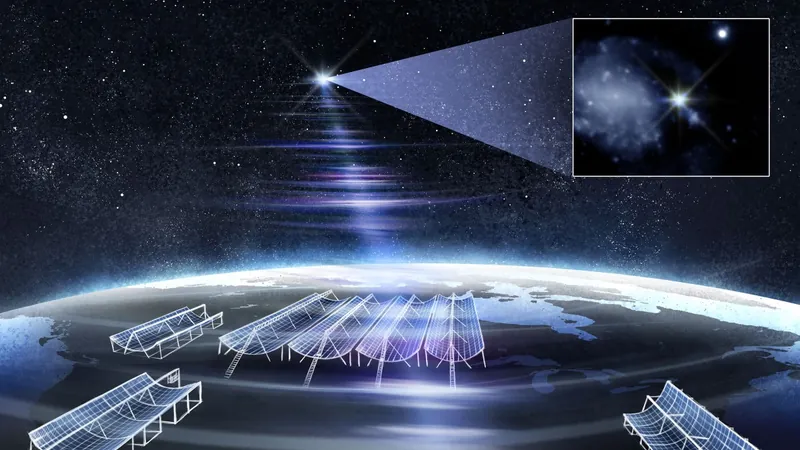
Unlocking the Mystery: James Webb Telescope Reveals Source of Record-Breaking Radio Flash
2025-08-22
Author: Nur
Astronomical Breakthrough with the James Webb Space Telescope
In an unprecedented feat, scientists have harnessed the power of the James Webb Space Telescope (JWST) to trace the origins of the brightest radio signal ever detected, a flash that zipped past Earth earlier this year.
A Cosmic Journey to Understanding Fast Radio Bursts
Tracking this enigmatic signal to the fringes of a galaxy 130 million light-years away, researchers utilized JWST's advanced infrared capabilities to pinpoint a massive explosion from an ancient star, suspected to be linked to the mysterious radio burst. The research team zoomed in on nearby stars, revealing the radio burst's environment with stunning clarity.
These findings, published on August 21 in The Astrophysical Journal Letters, could be a game changer in our understanding of fast radio bursts (FRBs), which have long baffled scientists trying to link them back to their galactic homes.
A New Era of Discovery
Peter Blanchard, a research scientist at Harvard University and lead author of one of the studies, remarked, "The high resolution of JWST allows us to resolve individual stars around an FRB for the first time. This opens the door to understanding the stellar environments that could give rise to such powerful bursts."
What Are Fast Radio Bursts?
Fast radio bursts are brief yet incredibly powerful pulses of radio energy, typically lasting just milliseconds but releasing more energy in that short span than the Sun emits over several days. Since their discovery in 2007, astronomers have cataloged over 1,000 FRBs across the universe, yet many of these bursts remain elusive and difficult to study.
The Record-Breaking RBFLOAT
In March, the Canadian Hydrogen Intensity Mapping Experiment (CHIME) detected the brightest radio burst ever recorded, officially labeled FRB 20250316A, and nicknamed "RBFLOAT" (Radio Brightest Flash Of All Time). Its extraordinary brightness suggested it originated relatively close to the Milky Way, making it an ideal candidate for further observation.
Unraveling the Location Mystery
Using CHIME's new Outrigger array of telescopes spreading from California to British Columbia, the team pinpointed the burst’s location to the galaxy NGC 4141, nestled within the Big Dipper. They narrowed it down to a minuscule region of space just 45 light-years wide—a remarkable feat likened to spotting a quarter from over 62 miles away.
JWST’s Revelation: The Progenitor Star
Upon further investigation with the JWST, the telescope not only detected an infrared burst at the exact coordinates of RBFLOAT but also examined surrounding stars. The data indicated that this infrared source could either be a red giant star nearing its life’s end or a massive star many times larger than our Sun. Interestingly, it’s possible that an unseen neutron star, known for its intense energy, is orbiting the infrared object, potentially leading to the bright radio burst.
Hypotheses for the Cause of the Burst
Beyond this, the team proposed a second scenario: a more massive star in the vicinity may have already collapsed into a magnetar—a type of neutron star capable of generating FRBs. Although this star remains undetectable by JWST, its presence could explain the radio signals.
Conclusion: A Significant Leap in Understanding
As researchers continue to piece together the puzzle of RBFLOAT, these findings underscore the newly enhanced capabilities of the CHIME experiment in localizing elusive FRBs, coupled with the JWST’s impressive observational powers. The journey to trace FRBs back to their origins not only addresses one of astrophysics' greatest mysteries but also enhances our understanding of how stars evolve during their intense and luminous lives.

 Brasil (PT)
Brasil (PT)
 Canada (EN)
Canada (EN)
 Chile (ES)
Chile (ES)
 Česko (CS)
Česko (CS)
 대한민국 (KO)
대한민국 (KO)
 España (ES)
España (ES)
 France (FR)
France (FR)
 Hong Kong (EN)
Hong Kong (EN)
 Italia (IT)
Italia (IT)
 日本 (JA)
日本 (JA)
 Magyarország (HU)
Magyarország (HU)
 Norge (NO)
Norge (NO)
 Polska (PL)
Polska (PL)
 Schweiz (DE)
Schweiz (DE)
 Singapore (EN)
Singapore (EN)
 Sverige (SV)
Sverige (SV)
 Suomi (FI)
Suomi (FI)
 Türkiye (TR)
Türkiye (TR)
 الإمارات العربية المتحدة (AR)
الإمارات العربية المتحدة (AR)